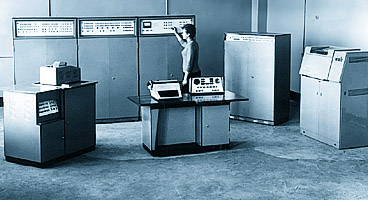Digital Electronic Computer 'MINSK-23'
Home → Articles → Minsk Family of Computers → Digital Electronic Computer “MINSK-23”
G.D.Smirnov, Y.V.Karpilovich, A.V.Grekovich

- Chief designer: V.V. Przhijalkovskiy, dep. chief designer: G.D. Smirnov
Designers: V.P. Kachkov, M.S. Margolin, N.A. Maltsev, Y.G. Bostandzjan, V.A. Averjanov, A.P. Kondratjev. - Developing organization: Special Design Bureau of G.K. Ordzhonikidze computing machines plant in Minsk. Subjected to the Byelorussian Council of national economy.
- Manufacturing plant: Minsk, G.K. Ordzhonikidze computing machines plant. Byelorussian Council of national economy.
- Completing of design phase: 1966.
- Beginning of serial production: 1966.
- Finishing serial production: 1969.
- Application field: Computer “Minsk-23” was the first soviet computing machine with symbolic logic and variable length of words and instructions. Designed for processing of large arrays of alphanumerical information.
- Number of produced computers (serial manufacturing): 28 pieces.
Description of the Computer (structure and architecture, including peripheral devices)
Structure of computer “Minsk-23” and system of instructions was absolutely different from the previous models.
Basic Components
Semiconductor triodes P16A (П16А), diodes D9 (Д9), diode-transformer circuits, operating on frequency 250 KHz.
Design
Blocked structure. The blocks were logically and technically completed devices; they could be produced independently.
Technology
Computer “Minsk-23” (“Минск-23”) was manufactured with the use of basic technological processes; among them the forming and shape-generating could be especially emphasized.
Software
Testing software, program library, symbolic-coding system, autocode with macrogenerating program, operating system (batch processing monitor, linking-loader, operator-machine subsystem, error locating system, multiprogram processing coordinator).
Technical and operating characteristics
- Average speed — 6.000 ops;
- RAM capacity — 40.000 symbols;
- External memory capacity — 44.000.000 symbols.
Specific features of the computer
Architecture of computer “Minsk-23” and its instruction set was absolutely different from all previous computers. That was the first soviet computer with symbolic logic and variable length of words and instructions. The computer had full-scale interruption and hesitation system, universal connection with peripheral devices, protected storage area with service programs, possibility of usage a large number of index fields for each program array, special instructions for editing and processing fields of variable length consisting of alpha-numeric symbols.
Parameters of computer “Minsk-23” were very close to processing procedures for various kinds of information. It had the following specific features:
- variable length of word and instruction, what made possible the most economic usage of storage volumes, combined and processed information given in various structures;
- decimal system of computations, which shuts-out information transference from one system into another one, decimal system also creates maximal correspondence between the source language and the machine language;
- it makes possible operation with 64 various peripheral devices, thus it enables devising of various information processing systems on basis of the computer;
- effective instruction set, including special find commands, editing commands and variety of logic instructions, what significantly simplified information processing.
In “Minsk-23” computer memory each alpha-numeric character receives an address and the information processing is performed step by step. Each character is represented with 8 binary places.
“Minsk-23” was the first computer operating with the following categories of information: number, alpha-digital word, array. With those categories it was possible to comprise most of the formats of production information, such as: document, cluster of documents from the same production area, array of documents from a production unit, etc. All categories were represented in computer with a sequence (chain) of symbols. All categories had random length – it was not limited. The following dividers of information were implemented:
- a) label name – «1» in place «M» of a symbol – divided numbers form instructions;
- b) mark – special symbol to divide alpha-numeric words;
- c) array boundaries – special symbol divided arrays.
“Minsk-23” was the first computer with universal system of connection with peripheral devices. Up to 64 devices could be connected to it.
There were two kinds of instructions for control over peripheral devices, one of them defined input mode, the other one — output mode. Number of the peripheral device was specified with the statement specificator. Information exchange between computers and external devices was combined with performance of operations in computing device. The multiprogram and multioperation modes – interruption mode and hold mode, were implemented for that purpose.
For organizing multiprogram operation of “Minsk-23” special addressable storage (memory, AMU) was implemented. That device could be considered -as if- consisting of two parts (“virtual division”). The first part comprised 8 programming levels – accordingly to simultaneously performed programs. Each level consisted of 8 registers storing the information necessary for performing one program, namely: the next instruction address, operand addresses, program and information bases, etc.
Thus at each action (external or programming), transition from one program to another one was performed by simple changing of operational level.
64 duty registers were placed in the second part of the addressable storage for information exchange between the computer and external devices. Those registers contained addresses of the operative storage cells, in which information is recorded or read out. Each query of every external device suspended program performance for one cycle of operative storage, for reading (or recording) of one symbol from/to corresponding duty register, according to its address, and increasing its contents by one to prepare it for the next call.
Sources: (used literature)
-
10 (patented) inventions of V.V. Przhiyalkovskiy, G.D. Smirnov, V.A. Averjanov and others had been implemented in computer “Minsk-23”.
-
The book: “Basic principles of the computer «Minsk-23» operation” (by M.S. Margolin, M.G. Skoromnik, G.K. Stolyarov, L.G. Chuprigina. Published in Moscow, “Statistika”, 1970).
Translated by A. Nitussov



